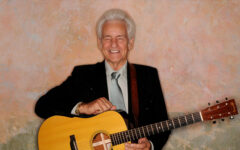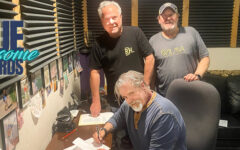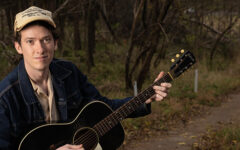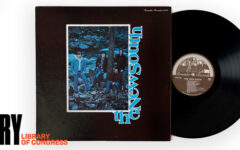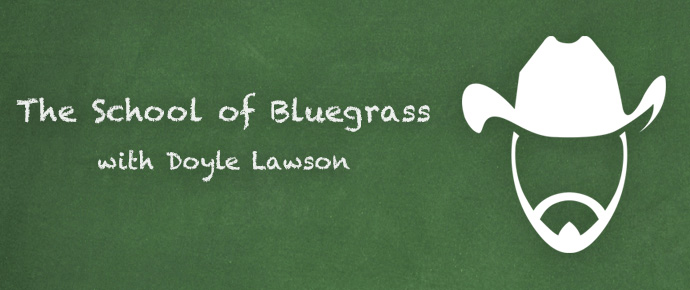
In this recurring column, bluegrass legend Doyle Lawson answers your questions about his storied musical career. To ask a question, either comment below, or send us your question by email.
Howdy folks howdy… (my best imitation of Mr Monroe) and I must say it looks a lot closer to him than it would sound if verbal! So here we go with more answers for inquiring minds.
While I’ve other memories of you and your band, as things turned out my memories are always going to feature the tornado scare in Charlotte, Michigan, last June (loved the unaccompanied Gospel set at the end, by the way). So: Any stories about storms and bad weather to tell?
Thanks, of course, for years of excellent music.
Joel Dinda
Joel Dinda, that was quite a scare last year in Charlotte, MI for everyone attending the festivals, as well as everyone in the surrounding area. I was pretty amazed as to how everyone stayed pretty calm during the crucial tornado watch I don’t remember which one of my guys suggested us leaving to try and get out of the potential storms way, but I said that we were better off staying out than trying to outrun the tornado should we get in its path. I was just thankful that it passed and the festival was able to continue with some adverse weather, and we gave our best to the people who stayed with us that day.
I will share this story and try to make it as brief as possible.
In March of 1963 I was on a 33 day tour as a banjo man for Jimmy Martin, and we were out in western Canada and working a series of shows. One night we finished a concert in Calgary, Alberta and headed back to North Battleford, Saskatchewan where we were based, and encountered a snowstorm unlike anything I had ever seen. Needless to say we were not prepared for weather this severe. We toured in Jimmy’s ’59 Cadillac, and of course, had no snow tires or chains, and the car started riding up on the snow and losing traction. It was either Paul Williams or Kirk Hansard driving, and I was sitting up front on the passenger side when I just happened to see a little side road off to our left, and suggested that we try and back the car into that road and maybe some vehicle would come along and knock the snow down enough to continue on.
So we did get parked and proceeded to wait and hope, but we were getting low on fuel and had to shut the engine off to save gas. And if that wasn’t bad enough, while we were doing our show in Calgary someone had broken the wing glass on the passenger side trying to break into the car. All I had with me for warmth was a sports jacket that I sometimes wore onstage, and I tell you I thought I would freeze to death! Thankfully we hadn’t been there long before I saw a set of headlights headed in our direction, and when they went by us we saw that it was a Volkswagen and looked much like a snow plow the way it was scattering the snow. And yes, there was a big Cadillac on its tail for sure.
There’s more to the story, but we made it back to North Battleford sometime after lunch and where the temperature was a balmy 13 below zero.
Doyle, thank you for bringing up the Tucker mandolin you once owned. I own that mandolin now, and would love to learn its history while it was with you. Thank you for being here.
Gerald Harbour
Gerald Harbour thanks for your question regarding Tucker mandolins.
Melvin Tucker was a fine fellow, and I met him at The Lewis Family festival in Lincolnton, GA. As I recall someone, and I don’t remember who, introduced me to Melvin, and he said that he built mandolins and asked if I would have a look at one. Of course I said yes, and I sat and played for awhile and told him that I thought it was a fine instrument. He then asked me if I thought it was good enough for me to play onstage, and I said yes. It wasn’t long before he brought me a mandolin as a gift, and I told him that I wouldn’t be using it as much as he might want because I had an agreement with John Paganoni, and that was my first priority. He understood that, and so that’s how it began.
When Dale Reno and Paul Williams heard it they both liked and got a Tucker. Later Melvin brought me the prototype of the A model he built for awhile, and I bought that one and kept it for a good while. In truth, I let them both go because I felt that they needed to be where they would be played more than they needed to be just sitting around.
Hey, Doyle, so glad you are a part of the Bluegrass Today site.
Looking back at your time with King Jimmy Martin, I am curious to know if you personally worked with Alan Munde on developing his style to to fit Jimmy. He is a monster with fiddle tunes and flawless melodic style, but his playing during his time with the Sunny Mountain boys was punchy and Crowe-like all the way (IMO). Alan is one of the greatest for sure. Thanks!
David Russell
Hey David, here’s my recollection regarding Alan Munde coming to Jimmy Martin.
When I decided to go back to work for Jimmy in ’69, it was to fill the banjo slot because Chris Warner (another mighty good banjo man) was going back to Pennsylvania. Chris stayed on board for awhile, so I was playing mandolin and Vernon Derrick had moved over to just the fiddle. When I went to work with J.D. in ’66 I pretty much stopped playing banjo other than occasionally doing a twin banjo instrumental with him, and I was really out of practice, banjo wise.
So I suggested to Jimmy that we find a banjo picker and leave Vernon on the fiddle and me on mandolin. During the DJ convention week that they used to do in Nashville every year I happened to run in to Alan downtown, and after small talk I asked what he was doing at present. He said he was sort of at loose ends and I said, “do you want a job, Jimmy’s looking for somebody.” I had met Alan sometime before and I seem to recall he, along with Sam Bush and a fellow named Wayne Stewart working as a trio, and I was really impressed with Alan’s banjo work. Anyway, I went back to Jimmy’s and told him I had found a good banjo man and who it was.
Surprisingly, Jimmy had heard him pick, but said that he didn’t play his (Jimmy’s) style, to which I replied, “no but he can.” Jimmy then said that he just wasn’t up to teaching somebody to play like he wanted, and I told him if he would hire him that I would rehearse him and he wouldn’t even have to be there. Well the beauty of it all was that neither I nor anyone else had to teach Alan Munde anything about banjo. He’s a stylist in his own right, and always when I heard him I knew who it was.
And yes he played Sunny Mountain banjo!
Doyle – Born and raised in New York City and a big fan. Thanks for so much great music over the years. I was surprised when Randy Graham joined Quicksilver, and wondered how you could have two such strong and similar tenor voices in the same band – which it clearly did! How did you go about making that work?
Eric Savage
Eric, you’re digging deep into my memories, but this is my answer.
Lou Reid left to go to Ricky Skaggs’ band in 1982, and everyone knows what powerhouse vocalist he was and still is. It was crucial to find someone who could bring it the way Lou had done, and as it happened Randy Graham had relocated to Arizona after several years as a founding member of The Bluegrass Cardinals. Hey, it was a shot in the dark but I called him ( believe that it was Baucom who came up with his number) and offered him the job, and was surprised and happy he accepted.
Regarding blending the vocals, I knew that there would be no problem on the high end, and so each song we did we looked for where the vocals worked best. Being the first replacement in DL&Q there couldn’t have been a better choice than Randy!
That’s it for this week, and wish al you the best for now.
Doyle

